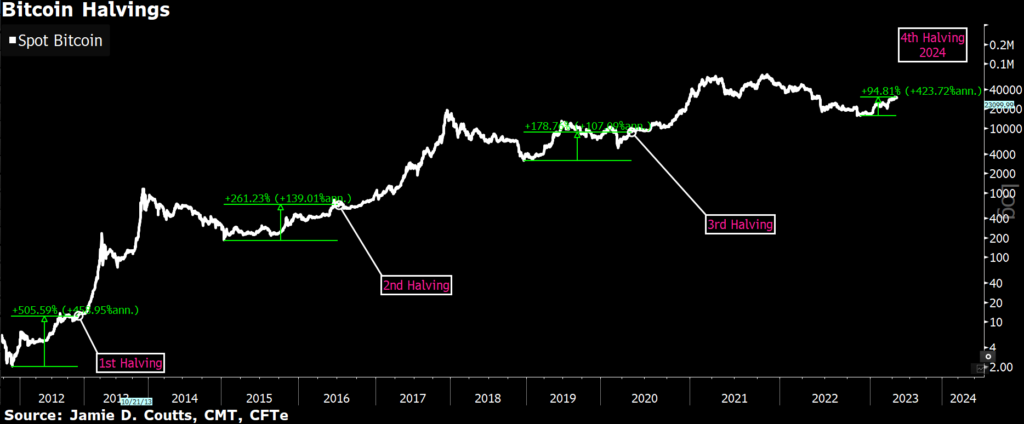
Bitcoin ‘Halving’ Spurs Prediction of Rally Past $50,000 by 2024. In a recent video by Bloomberg Technology, CS Labs 21 CEO and former BitPay CCO Sonny Singh discusses his belief in the logic behind Bitcoin’s halving. Singh explains that Bitcoin’s halving, which occurs every four years, reduces the supply of the cryptocurrency and makes it more deflationary. With the next halving scheduled for April 2027, Singh predicts media frenzy and a potential price run-up in the coming months. Despite the challenges faced by the crypto industry, including banking regulations and difficulty in obtaining banks, the price of Bitcoin has rallied from $16,000 to almost $30,000 in the past six months. Singh even speculates that Bitcoin could reach $40,000 this year.
The discussion also touches upon the difficulties faced during the seed stage of crypto companies, particularly following the collapse of Silicon Valley Bank. Singh admits that it was much harder to secure investors since they have become more cautious in the industry. However, despite the obstacles, Singh’s company successfully raised a $4 million seed round in 45 days from both crypto investors and traditional investors. The video also highlights the regulatory headwinds that continue to worry the crypto industry, particularly regarding the analysis of crypto assets by the FCC and the potential expansion to non-US-based derivative platforms. Overall, the crypto industry remains resilient and determined to navigate through challenges, with companies like Gemini and Coinbase eyeing the derivatives market.
Bitcoin’s Halving
The halving process in Bitcoin is an event that occurs approximately every four years, which involves a reduction in the rewards that miners receive for validating transactions on the network. This reduction is implemented through a predetermined algorithm that cuts the block rewards in half. The purpose of this process is to control the rate at which new Bitcoins are created and to ensure that the supply is limited.
Explanation of the halving process
Bitcoin’s halving process is built into its protocol and is based on the idea that as the supply of new coins dwindles over time, scarcity increases, potentially leading to an increase in value. By halving the rewards for miners, it not only reduces the number of new coins entering circulation but also slows down the rate at which new coins are mined. This helps maintain the balance between supply and demand.
Impact of halving on Bitcoin supply and inflation
The halving has a significant impact on Bitcoin’s supply and inflation. With each halving event, the rate at which new coins are created is reduced by half. This slow and predictable issuance schedule ensures that the supply of Bitcoin remains limited, which in turn can lead to increased demand and potential price appreciation. Additionally, the decreasing rate of inflation over time makes Bitcoin a deflationary asset, contrasting with traditional fiat currencies that are subject to inflationary pressures.

This image is property of i.ytimg.com.
Scheduled date of next halving
The most recent Bitcoin halving occurred in May 2020, reducing the block rewards from 12.5 to 6.25 Bitcoins per block. Based on the four-year halving cycle, the next halving is projected to take place in 2024. However, it is important to note that the exact timing may vary slightly due to the decentralized nature of the Bitcoin network and the variability in block mining times.
Bitcoin’s Price Prediction
The relationship between Bitcoin’s halving and price increase has been a topic of much speculation and debate within the cryptocurrency community. The theory suggests that the reduction in supply, coupled with increasing demand, can potentially lead to a rise in Bitcoin’s price. Historical data indicates that previous halving events have indeed been followed by substantial price increases in the months and years that followed.
Expectations of media frenzy leading up to halving
As the next halving approaches, it is expected that the media coverage and public attention surrounding Bitcoin will intensify. The halving event has gained significant mainstream recognition, attracting attention from both traditional financial institutions and retail investors. This media frenzy and increased awareness often result in a surge in demand for Bitcoin and can contribute to upward price momentum.

This image is property of assets.bwbx.io.
Anticipated price run-up
Based on historical patterns, it is anticipated that there may be a price run-up in the period leading up to the halving event. This anticipation stems from investors’ belief that the reduction in supply, combined with heightened attention, will drive up the value of Bitcoin. However, it is important to acknowledge that market dynamics can be complex, and past performance does not guarantee future results.
Effect of Banking Crisis
The occurrence of a banking crisis can significantly impact investor sentiment and the overall landscape of the crypto industry. During times of economic uncertainty, individuals and institutional investors often seek alternative assets and stores of value. This increased interest in cryptocurrencies, including Bitcoin, can result in a rise in demand and potentially drive up prices.
Difficulties faced by crypto companies in accessing banking infrastructure
One notable challenge faced by crypto companies is the difficulty in accessing traditional banking infrastructure. Due to concerns around regulatory compliance, anti-money laundering (AML) measures, and the still-developing nature of the crypto industry, many banks are hesitant to provide banking services to cryptocurrency-related businesses. This lack of access to essential financial services creates obstacles for companies operating in the space.

This image is property of assets.bwbx.io.
Rising banking regulations and their impact on the industry
The crypto industry is experiencing an increase in regulatory scrutiny, as governments and regulatory bodies around the world strive to establish frameworks to govern the use and exchange of cryptocurrencies. While regulations are crucial for fostering trust and protecting investors, overly restrictive or unclear regulations can stifle innovation and hinder the growth of the industry. Striking the right balance between regulation and innovation remains a challenge.
Crypto Investment and Funding
Amidst the challenges faced by the crypto industry, some companies have managed to secure successful seed round funding. For example, CS Labs 21, a blockchain technology startup, recently completed a seed funding round, attracting investors looking to capitalize on the potential of crypto-related products and services. This success demonstrates that there are still opportunities for crypto companies to secure funding despite the cautiousness of some investors.
Challenges faced due to cautious investors
While there are opportunities for funding, cautiousness among investors remains a hurdle in the crypto space. The volatility and perceived risks associated with cryptocurrencies have led some investors to be cautious and skeptical. This wariness can make it more challenging for crypto entrepreneurs to attract funding and achieve the necessary capital to grow their businesses.

This image is property of images.moneycontrol.com.
Crypto investing in Silicon Valley
Silicon Valley, known as a hub for technological innovation and venture capital, has seen a significant interest in crypto investing. High-profile venture capital firms and angel investors in the region have directed funds toward crypto startups and projects. This influx of capital and expertise has contributed to the growth and development of the crypto ecosystem in Silicon Valley.
Regulatory Headwinds
Regulatory scrutiny remains a contentious issue within the crypto industry. Concerns are primarily focused on how digital assets, including cryptocurrencies, should be classified and regulated. Different countries and jurisdictions have varying approaches, ranging from strict regulations to more supportive frameworks. The lack of uniformity and clarity can create challenges for crypto businesses, as they navigate different regulatory landscapes.
Examples of key players seeking licenses in Bermuda
To address regulatory uncertainties, some key players in the crypto industry have sought licenses in jurisdictions that offer a more favorable regulatory environment. Bermuda, for instance, has positioned itself as a crypto-friendly jurisdiction and has attracted companies such as Binance, the world’s largest cryptocurrency exchange, and Circle, a prominent digital asset company. By obtaining licenses and operating within established frameworks, these companies seek to gain regulatory certainty and foster trust.
This image is property of vid.alarabiya.net.
Impact of regulatory uncertainty on the crypto industry
The ongoing regulatory uncertainty can have significant implications for the future of Bitcoin and the broader crypto industry. Lack of clarity and inconsistent regulations across jurisdictions can hinder innovation and deter institutional investors from entering the space. Regulatory developments play a crucial role in shaping the industry’s landscape, and striking the right balance between consumer protection and fostering innovation remains a priority.
Crypto Players’ Compliance Efforts
To address regulatory concerns and maintain legitimacy, crypto players have been working towards adhering to regulations and cooperating with regulatory bodies such as the U.S. Securities and Exchange Commission (SEC). By proactively engaging with regulators, crypto companies aim to establish a framework that balances regulatory oversight with the benefits offered by blockchain technology and cryptocurrencies.
Obtaining licenses, such as the New York license
Obtaining licenses is an essential step for crypto companies seeking to operate within regulated jurisdictions. One notable example is the New York BitLicense, introduced by the New York State Department of Financial Services. While the BitLicense has been criticized for its strict requirements, obtaining it allows companies to legally operate in the state and demonstrates a commitment to regulatory compliance.
Challenges with changing regulatory landscape
The rapidly evolving regulatory landscape poses challenges for crypto businesses. Navigating complex and changing regulations demands resources, expertise, and a deep understanding of the legal frameworks. Companies must adapt quickly to comply with new regulations, which can impact their operations and require additional compliance measures. This constantly shifting landscape emphasizes the need for collaboration between industry participants and regulators to establish clear guidelines.
Opportunities in Offshore Markets
As regulatory challenges persist, some crypto companies have explored offshore markets for growth opportunities. These markets often offer more flexible regulatory frameworks and can provide an avenue for expansion. Gemini and Coinbase, two prominent cryptocurrency exchanges, have expressed interest in offshore opportunities to diversify their operations and tap into international markets.
Gemini and Coinbase’s interest in offshore opportunities
Both Gemini and Coinbase have been actively pursuing expansion into offshore markets. For example, Gemini has obtained licenses to operate in various jurisdictions, including the United Kingdom and Singapore. Coinbase, on the other hand, has expanded its footprint into multiple countries, offering its services to a global customer base. These moves highlight the significance of offshore markets in the growth strategies of major crypto players.
FTSE USA RTX and the void in international trading markets
The lack of international trading markets that offer exposure to cryptocurrencies has led to the development of innovative financial products. For instance, the FTSE USA RTX index, launched by Cryptoindex, provides investors with a way to gain diversified exposure to the U.S. market through a tokenized index. This initiative showcases the opportunities that arise when bridging the gap between traditional financial markets and the crypto industry.
Future of Bitcoin
The future of Bitcoin remains a subject of speculation and debate. Predictions of future price increases vary widely, with some experts suggesting that Bitcoin could reach astronomical prices while others remain skeptical. The growth of cryptocurrency will likely depend on numerous factors, including institutional adoption, regulatory developments, technological advancements, and global economic conditions.
Speculations on future price increases
Some speculations suggest that Bitcoin’s price could experience significant increases in the years to come. Proponents point to the limited supply of Bitcoin, increasing institutional interest, and growing acceptance of cryptocurrencies as a store of value. However, it is important to note that the cryptocurrency market is highly volatile and subject to various external factors, making accurate price predictions challenging.
Factors influencing the growth of cryptocurrency
Several factors have the potential to influence the growth of the cryptocurrency industry. Institutional adoption, such as the entrance of financial institutions and corporations into the market, can bring both credibility and increased liquidity. Technological advancements, including scalable and efficient blockchain solutions, can enhance the usability and efficiency of cryptocurrencies. Additionally, regulatory developments and global economic conditions can shape the regulatory environment and overall market sentiment.
Potential impact of derivative markets
The emergence of derivative markets for cryptocurrencies, such as Bitcoin futures and options, has the potential to impact the ecosystem significantly. Derivatives allow investors to speculate on the price of Bitcoin without actually owning the underlying asset, introducing new avenues for participation and risk management. Greater access to derivatives markets can contribute to increased liquidity and potentially influence price dynamics.
Conclusion
In conclusion, Bitcoin’s halving process, coupled with the anticipation of price increases, has become a central focus within the cryptocurrency community. While the event itself has historically led to price appreciation, the impact on the industry extends beyond short-term price movements. The crypto industry faces challenges stemming from regulatory uncertainties, difficulties accessing banking infrastructure, and cautious investor sentiment. However, opportunities for growth and development persist, with companies seeking to comply with regulations, exploring offshore markets, and capitalizing on technological advancements. The future of Bitcoin and the broader cryptocurrency industry hinges on the ability to navigate these challenges and capitalize on the opportunities that arise.




